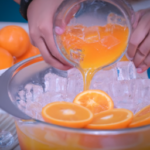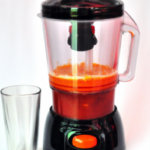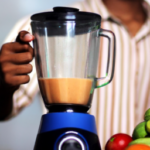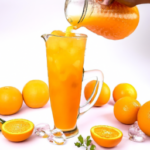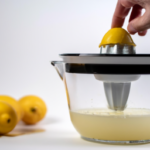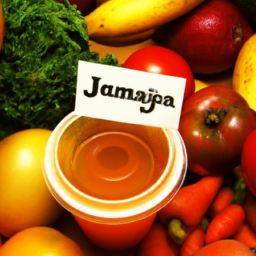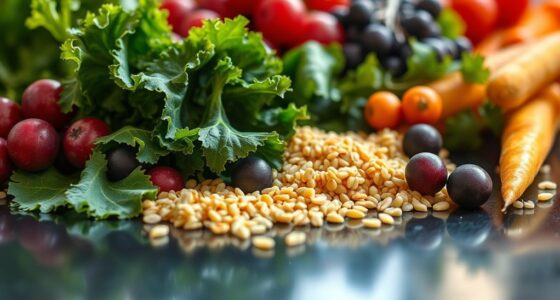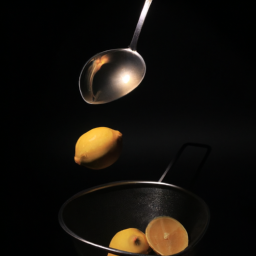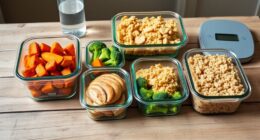If you want to make delicious, long-lasting juice at home, choosing to create your own juice concentrate is a great option. This method allows you to control the ingredients in your juice and also helps you make better use of your fruits and vegetables.
To get started, you’ll need to choose your fruits and vegetables. Consider which flavors you enjoy and which ones pair well together. Once you have your produce, you’ll need to prepare it by washing and cutting it into small pieces.
From there, you can blend the produce together to create a juice base. After straining the juice, you’ll need to reduce it by simmering it over low heat until it thickens into a concentrate. Once it’s cooled, you can reconstitute the concentrate with water or other liquids to create a delicious juice.
With a little experimentation, you’ll be able to create a variety of flavors and techniques that suit your tastes. So, let’s get started on learning how to make juice concentrate!
Key Takeaways
- Properly preparing produce is crucial in making high-quality juice concentrate.
- Airtight glass containers are the best option for storage to prevent oxidation.
- Experimenting with different fruits, vegetables, and techniques can lead to unique and delicious flavor combinations.
- Juice concentrate is packed with nutrients and fiber, making it a healthy option for regulating the digestive system and reducing the risk of chronic diseases.
Choose Your Fruits and Vegetables
Now that I’ve decided to make juice concentrate, I need to choose my favorite fruits and veggies. Exploring flavor profiles is a key consideration when selecting produce.
For example, if I want to make a sweet and tangy juice, I could choose a combination of oranges, lemons, and pineapples. Alternatively, if I want a more earthy and savory flavor, I might go for beets, carrots, and spinach. It’s important to choose fruits and vegetables that will complement each other and create a balanced flavor profile.
Another essential aspect of making high-quality juice concentrate is sourcing high-quality produce. This means selecting fresh fruits and vegetables that are ripe and in season. I might visit a local farmer’s market or grocery store that specializes in organic and locally sourced produce.
By selecting the best possible ingredients, I can ensure that my juice concentrate will taste delicious and be packed with nutrients. Now it’s time to prepare my produce and get started on the next step.
Prepare Your Produce
First, gather fresh, ripe fruits and vegetables from your local market or garden. When selecting produce for juice concentrate, it’s important to choose fruits and vegetables that are in season and at their peak ripeness. This will ensure that you get the most flavor and nutrients out of your produce.
Some great options for juice concentrate include citrus fruits, berries, apples, carrots, and beets. Once you have your produce selection, it’s time to prepare it for juicing.
Wash all fruits and vegetables thoroughly to remove any dirt or debris. Cut them into smaller pieces that will fit into your juicer. It’s also a good idea to remove any seeds or stems that may affect the flavor of your juice.
There are different juicing techniques that you can use depending on the type of produce you are using, so be sure to do some research to find the best method for your specific fruits and vegetables. With your produce properly prepared, you’re ready to move on to the next step: blending your produce.
Blend Your Produce
After properly preparing your produce, it’s time to blend it into a delicious and nutritious beverage. When it comes to blending techniques, there are a few things to keep in mind.
First, make sure that you have a powerful blender that can handle the tough fibers of fruits and vegetables. A high-speed blender is ideal for making juice concentrate as it can quickly break down the produce into a smooth consistency.
Next, add your prepared produce to the blender and blend until smooth. You may need to add some water to help the process along, but be careful not to dilute the juice too much. The amount of water needed will depend on the type of produce you are using and your desired consistency.
Finally, be sure to blend the mixture well to ensure that all the nutrients are released from the produce. The nutritional benefits of juice concentrate are immense, so make sure to blend your produce thoroughly to get the most out of your juice.
As you blend your produce, you may notice that the mixture becomes thicker and more concentrated. This is a good sign that your juice concentrate is coming along nicely. Once you have blended your produce to your desired consistency, it’s time to strain the juice.
Strain the Juice
To get the smoothest and most refreshing texture, strain the blended produce through a fine-mesh sieve or cheesecloth, allowing the juice to drip into a container. It’s like squeezing every last drop of goodness from a sponge.
There are various straining techniques that you can use, depending on how much pulp you want in your concentrate. Here are some benefits of pulp inclusion that you should consider before deciding how to strain your juice:
- Pulp is rich in fiber, which can help regulate your digestive system and reduce the risk of chronic diseases.
- Pulp contains vitamins and minerals that are essential for your body’s overall health and well-being.
- Pulp can add texture and thickness to your juice, making it more satisfying and filling.
- Pulp can also enhance the flavor of your juice, providing a more complex and nuanced taste profile.
With these benefits in mind, you can decide whether to strain your juice completely for a smooth and silky texture, or to leave some pulp in for added nutrition and flavor.
Once you have strained your juice to your desired consistency, it’s time to move on to the next step: reducing the juice.
Reduce the Juice
Now, you’ll want to boil the strained juice until it reduces to a concentrated form, intensifying its flavor and nutritional content. Reducing the juice is a crucial step in making juice concentrate as it removes excess water content and concentrates the natural sugar and nutrients present in the fruits.
The benefits of juice reduction are manifold. It not only enhances the taste and aroma of the juice but also prolongs its shelf life. The concentrated juice can be stored in airtight containers in the refrigerator or freezer for future use.
To achieve perfect juice consistency, it’s essential to keep an eye on the juice as it reduces. The boiling point of the juice should be carefully monitored as overheating can cause the juice to burn and lose its flavor. Stir the juice occasionally to prevent it from sticking to the bottom of the pan.
The reduced juice should have a thick and syrupy consistency, similar to honey. Once you’ve achieved the desired consistency, turn off the heat and let the juice cool down before proceeding to the next step of adding sweeteners (optional).
Without compromising on flavor or nutrition, juice reduction is an easy and effective method to make juice concentrate. By following these tips, you can ensure that your juice has the perfect consistency and is ready for the next step of sweetening.
Add Sweetener (Optional)
To continue making juice concentrate, it’s time to add some sweetness. This step is optional, but adding sweeteners can make the concentrate more palatable and enjoyable.
As someone who has a sweet tooth, I always add a little bit of sweetness to my juice concentrate.
There are many benefits to using sweeteners in juice concentrate. For one, it can help balance out the tartness of certain fruits. Additionally, sweeteners can help mask any bitterness that may be present in the concentrate.
However, it’s important to note that not all sweeteners are created equal. Some alternatives to traditional sugar include honey, maple syrup, and stevia. These options can offer a different flavor profile and may be a healthier choice for some individuals. Ultimately, it’s up to personal preference and dietary needs to decide which sweetener to use.
Now that the concentrate is sweetened to your liking, it’s time to move on to the next step: cooling the concentrate.
Cool the Concentrate
Now that we’ve sweetened our juice concentrate, it’s time to cool it down.
The first thing to consider when cooling your concentrate is choosing the right container. You want to use a container that is freezer safe and can hold the amount of concentrate you’re making.
Once you have your container, you can decide whether to store your concentrate in the fridge or freezer, depending on how soon you plan to use it.
Choosing the Right Container
You’ll want to make sure you choose the right container for your juice concentrate, as it’s crucial for its preservation and storage. The right container will keep your concentrate fresh and prevent it from spoiling too quickly.
When choosing the right container, make sure it’s made from a non-reactive material such as glass, stainless steel, or plastic. Avoid containers made from aluminum or copper, as they’re reactive and can affect the taste and quality of your concentrate.
Another important tip for storage and preservation is to make sure the container is airtight. Oxygen is one of the main culprits of spoiling juice concentrate, so it’s essential to keep it away from the concentrate. Airtight containers can prevent the oxidation process and keep the concentrate fresh for a longer period.
Now that you’ve chosen the right container, the next step is to find a suitable place to store it, whether in the fridge or freezer.
Storing in the Fridge or Freezer
For optimal freshness and longevity, it’s a must to store your juice concentrate in the fridge or freezer. Glass containers are the best option for storage. Glass is non-reactive and non-porous, so it won’t affect the taste or quality of your juice. Plus, it’s easy to clean and can be reused.
If you don’t have glass, you can still use plastic containers, but make sure they’re BPA-free and food-grade. You can keep juice concentrate in the fridge for up to two weeks. To extend its shelf life, store it in the freezer for up to six months. Keep in mind that the longer it stays in the freezer, the more it will lose its flavor and potency.
To ensure your juice concentrate stays fresh, label the container with the date it was made, and always use a clean utensil when scooping it out. Now that you know how to store your juice concentrate, it’s time to learn how to reconstitute it.
Reconstitute the Concentrate
To reconstitute the concentrate, simply mix it with water according to the package instructions and stir until fully dissolved.
There are various rehydration methods you can use, such as adding the concentrate to water in a pitcher or diluting it with a small amount of water first before gradually adding more.
It’s important to consider the shelf life of the concentrate when reconstituting it, as diluted juice should be consumed within a certain amount of time to prevent spoilage.
Once you’ve reconstituted the concentrate, you can use it in a variety of ways such as making juice, smoothies, cocktails, or even as a marinade for meat.
The possibilities are endless, and the concentrate provides a convenient and cost-effective way to enjoy your favorite fruit juices.
Use the Concentrate
Now that I’ve successfully reconstituted the juice concentrate, the next step is to use it for various purposes.
One of my favorite ways to use the concentrate is by making smoothies. The concentrated juice adds a burst of flavor to my smoothies, making them even more delicious.
Additionally, the concentrate can be used to create cocktails or mixed with other juices to create unique flavor combinations.
Making Smoothies
Smoothies are a delicious and healthy way to enjoy a variety of fruits and vegetables. Here are four tips for making the perfect smoothie using juice concentrate:
-
Choose your base: Start with a liquid base, such as water, milk, or yogurt, and add in your juice concentrate. This will give your smoothie a concentrated flavor and a boost of vitamins and minerals.
-
Add fruits and vegetables: Choose your favorite fruits and vegetables and add them to your smoothie. Some popular options include bananas, berries, spinach, and kale. These ingredients will give your smoothie a nutritious boost of fiber and antioxidants.
-
Add some sweetness: If you prefer a sweeter smoothie, add some honey, agave, or maple syrup. You can also add some vanilla extract or cinnamon for extra flavor.
-
Blend and enjoy: Put all your ingredients in a blender and blend until smooth. Pour your smoothie into a glass and enjoy!
Now that you know how to make a delicious smoothie using juice concentrate, let’s move on to creating cocktails.
Creating Cocktails
Mixing up cocktails is a fun and creative way to impress your guests and showcase your bartending skills. To create delicious cocktails, you need to have a solid understanding of mixology techniques and cocktail recipes.
Start by selecting your base liquor, such as vodka or rum, and then add complementary flavors through mixers, juices, and other ingredients. One of my favorite cocktail recipes is a classic margarita. To make this drink, combine tequila, lime juice, and triple sec in a shaker with ice. Shake well and strain into a salt-rimmed glass filled with ice. Garnish with a lime wedge and enjoy!
Experiment with different ingredients and flavors to create unique cocktails that your guests will love. When it comes to mixing with other juices, the possibilities are endless. Try adding a splash of orange juice to your margarita for a sweeter taste, or mix pineapple juice with rum for a tropical twist. Remember to balance the flavors and not overpower the taste of your base liquor.
With a little creativity and practice, you can become a master mixologist and create cocktails that will impress any guest.
Mixing with Other Juices
Enhance the flavor of your cocktails by incorporating a splash of your favorite fruit juice. Mixing different juices with your base liquor can create unique and delicious flavor combinations that will impress your guests.
Here are some tips to help you mix the perfect cocktail with fruit juice:
- Experiment with mixing ratios to find the perfect balance of flavors. A good starting point is one part juice to two parts liquor.
- Try different flavor combinations, such as orange juice with tequila or cranberry juice with vodka. Don’t be afraid to think outside the box and try new things.
- Consider the sweetness level of the juice you’re using and adjust accordingly. For example, if you’re using a very sweet juice, you may want to add less simple syrup or other sweeteners to your cocktail.
- Remember to taste as you go and make adjustments as needed. Mixing cocktails is both an art and a science, and finding the perfect balance of flavors takes practice and experimentation.
By following these tips, you can create delicious and unique cocktails that incorporate your favorite fruit juices. Next, we’ll discuss how to experiment with different flavors and techniques to take your cocktails to the next level.
Experiment with Different Flavors and Techniques
Now that I’ve learned how to make juice concentrate, I’m excited to experiment with different flavors and techniques.
One of the things I’m looking forward to is trying new combinations of fruits and vegetables to create unique and delicious blends.
I’ll also be exploring tweaking the recipe to adjust the sweetness or acidity levels to my liking.
Additionally, I’m planning on sharing my creations with friends and family to get their feedback and suggestions for future experiments.
Trying New Combinations
You’re probably tired of the same old juice combinations, but fear not, adventurous drinker! When it comes to making juice concentrate, the possibilities are endless. Juice concentrate experimentation is the perfect opportunity to explore new flavor combinations and experiment with techniques to achieve the perfect balance of sweetness and tartness.
To get started, consider mixing and matching flavors from different fruits and even vegetables. Here’s a table to help spark some ideas:
| Fruit | Vegetable | Flavor Profile |
|---|---|---|
| Apple | Carrot | Sweet and earthy |
| Orange | Ginger | Spicy and citrusy |
| Pineapple | Cucumber | Refreshing and tropical |
| Blueberry | Kale | Tart and antioxidant-rich |
Don’t be afraid to think outside the box and try new combinations. When experimenting with flavors, start with small batches and adjust the ratios of ingredients until you find the perfect blend. Once you’ve found your favorite flavor combination, you can tweak the recipe to achieve the perfect texture and sweetness level.
Tweaking the Recipe
To really get the perfect flavor and texture, try playing around with the amounts of ingredients in your recipe and see what works best for you! Adjusting proportions can make a huge difference in the taste of your concentrate.
For example, if you prefer a sweeter juice, try adding more sugar or honey to the mix. If you want a more tart flavor, add more lemon or lime juice. You can also try adjusting the amount of water in the recipe to get a thicker or thinner consistency.
Another way to tweak the recipe is by experimenting with flavor combinations. Adding a small amount of ginger or mint can give your juice a refreshing kick. You can even try adding a pinch of salt to bring out the natural sweetness of the fruit.
Don’t be afraid to get creative and mix and match different fruits and herbs to find your perfect flavor. Once you’ve found it, share it with friends and family and see what they think!
Sharing with Friends and Family
Sharing your homemade juice creations with loved ones can be a fun and rewarding experience, as it allows you to showcase your unique flavor combinations and bring joy to those around you. Whether you’re hosting a party or simply sharing a glass with a friend, there are a few tips to keep in mind to ensure that everyone enjoys your juice concentrate as much as you do.
First and foremost, make sure to label your juices with the ingredients used and any allergens present. This will allow your guests to make an informed decision and avoid any potential reactions. Additionally, it can be helpful to offer a variety of options, such as a citrus-based juice and a sweeter fruit option. Finally, don’t forget to serve your juices in stylish glasses or pitchers to enhance the overall experience. With these sharing tips in mind, you can spread the joy of homemade juice concentrate with ease.
Frequently Asked Questions
How long does homemade juice concentrate last in the freezer?
I froze my homemade juice concentrate and it lasted for up to 6 months in the freezer. The key is to store it in an airtight container and label it with the date. This ensures freshness and prevents freezer burn.
Can I use frozen fruits and vegetables to make juice concentrate?
Yes, frozen fruits and vegetables can be used to make juice concentrate. They have the benefit of being available year-round, and their flavor and nutritional value are comparable to fresh produce.
What is the ideal ratio of fruits and vegetables to use for making juice concentrate?
The ideal fruit to veggie ratio for juice concentrate varies based on taste preferences. However, a common ratio is 3:1 fruit to veggie. Experiment with ratios to find what works best for you.
Can I use a regular blender instead of a juicer to make juice concentrate?
Yes, a regular blender can be used for making juice concentrate, but the texture may not be as smooth. To achieve concentrated flavor, use a higher ratio of fruits to water and blend in smaller batches. Blender vs juicer for juice concentrate depends on personal preference.
Is it necessary to add citric acid or other preservatives to homemade juice concentrate?
Preservative free options for homemade juice concentrate exist. However, adding citric acid can increase shelf life. Health benefits of homemade juice concentrate include increased nutrient intake and reduced sugar content.
Conclusion
In conclusion, making juice concentrate is a simple process that requires a little effort and patience, but the end result is worth it. I’ve found that making my own juice concentrate allows me to create unique and delicious blends that aren’t available in stores. Whether you’re looking to save money, reduce waste, or just enjoy the flavor of fresh, homemade juice, making your own concentrate is a great option.
As the old adage goes, "an apple a day keeps the doctor away."While juice concentrate may not be a substitute for a balanced diet and regular exercise, it can be a tasty and convenient way to incorporate more fruits and vegetables into your daily routine. By following the steps outlined in this article, you can create your own juice concentrate from scratch and enjoy the benefits of fresh, flavorful juice anytime.
Ilana has been a vegan for over 10 years. She originally made the switch for health reasons, but soon found herself becoming more and more passionate about the ethical and environmental implications of a vegan lifestyle. Ilana is the author of The Graceful Kitchen, a blog all about veganism. She loves to cook up delicious and nutritious vegan meals, and share her recipes with others who are interested in leading a cruelty-free life. Ilana is also a strong advocate for using whole foods as the foundation of a healthy diet, and believes that going vegan is one of the best ways to achieve this.



